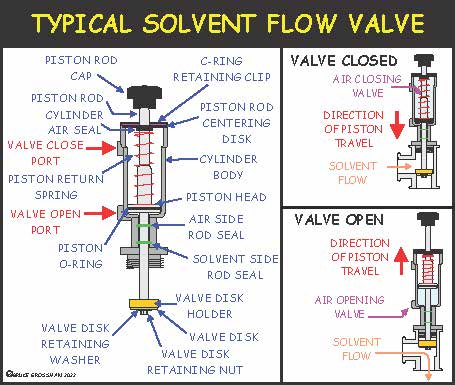In this month’s issue, which will conclude the solvent flow series, I’ll discuss valves, the devices that direct the solvent flow through the dry cleaning machine.
HOW SOLVENT FLOW VALVES OPERATE
The solvent flow control valves on almost every dry cleaning machine are operated by compressed air directed by a solenoid, which moves a piston inside a cylinder to position a disk. The position of this disk will either stop or allow solvent to flow through the valve.
There are two types of valves: single-acting valves and double-acting valves. Single-acting valves are commonly, but not always, configured in a normally closed position (stops the solvent flow) by spring action when the valve is not activated. Compressed air compresses the spring when the valve opens; when the air is exhausted, the spring expands, closing the valve. The other valve variant is the double-acting valve, in which compressed air positions the valve in either the open or closed position.

REASONS FOR VALVE FAILURE
- FAULT IN THE VALVE CONTROL SYSTEMS- Before engaging in any troubleshooting, be sure the incoming air pressure is at least 80 PSI. Problems in systems controlling the valves are often misdiagnosed as valve failures. These systems include the computer and the solenoid associated with the suspect valve. The easiest way to eliminate computer and solenoid faults is to disconnect the airline going to the suspect valve and activate the valve, either manually or through a cleaning program, to see if you get air out of the line. If there is airflow, the problem is likely in the valve itself.
- FOULED CYLINDER- Most plants don’t pay proper attention to the quality of the compressed air delivered to the equipment. Over time, poor air quality leads to the accumulation of grit and other contaminants in the air-operated components. Accumulating these contaminants in the cylinder area causes deterioration of the rubber components and excessive friction and wear on the piston O-ring, cylinder walls, and other seals within the valve. Most air-operated equipment has a filter/regulator and lubricator to treat incoming air. Most dry cleaners have never checked these components to ensure the filter/regulator drains water and the lubricator has oil and is properly adjusted. KEEP UP WITH MAINTENANCE ON THESE ITEMS, AND YOU WILL RARELY HAVE VALVE OR SOLENOID PROBLEMS!!!
- FAULTY O RINGS- The valve typically has two types of O-rings. The first type sits in a groove on the piston head and is used to seal the air on one side of the piston when the valve is operated. It is generally Buna and colored black. The second species of O-ring is used to seal the piston shaft. Usually, two are found at the bottom of the valve and are used to seal the cylinder section from the solvent flowing through the valve. On double-acting valves, at the top of the cylinder, there is another O-ring acting as a shaft seal. These O-rings are colored green or brown and made of silicone or Viton. Contamination within the cylinder often prevents proper movement of the piston within the valve, resulting in either faulty closing (sticking partially open when compressed air is exhausted) or faulty opening (sticking partially closed when the valve is pressurized). Partial closing causes solvent leakage through the valve, and partial opening reduces flow through the valve. Careful examination of the piston rod length, which extends past the top of the cylinder, can indicate when the valve is completely closed. Watch the operation of a similar valve. When the valve is shut, note how far the rod extends above the top of the cylinder. If the piston rod on the suspect valve extends further, it’s likely not shutting completely. I’ve found that removing the airline to the faulty valve and spraying WD-40 into the valve, if possible, as well as the airline, then operating the valve several times, will often remedy this problem.
- DEBRIS ON VALVE SEAT- Occasionally, a pin or some other type of debris will get stuck in the area where the valve disk seats, causing solvent to leak through the valve when it is shut. The cause of this condition will be apparent when the cylinder assembly is unscrewed from the valve seat. The procedures for this type of repair will be covered in another article soon.
PROBLEMS CAUSED BY FAULTY VALVE OPERATION
Problems caused by these types of valve failures are legion; to discuss them in depth would require a dedicated article. However, I’ve found from my service calls that the three most notable symptoms of valve failure are:
- Overfilling the still, caused by the still valve sticking partially open.
- The inability to draw solvent from solvent tanks because the button trap valve sticks partially open.
- During the drain cycle, the non-ending flow of solvent from the wheel (basket) caused by the wheel inlet valve sticking partially open.
Well, that’s it for now. Don’t know yet what I’ll be discussing next month.

Bruce Grossman
Bruce Grossman is the Chief of R&D for EZtimers Manufacturing. EZtimers is the manufacturer of the new EZ DOSE boiler compound manager and return tank level control which replaces that troublesome ball float valve in the condensate return tank and automatically adds the correct amount of boiler compound to the return tank preventing the oxygen corrosion and scaling. Our SAHARA and DIB-M high purity separator water mister/evaporators provide a thrifty, legal method to get rid of the separator water generated by your dry-cleaning machine. See our Ad in this issue and for further information on EZtimers products visit www.eztimers.com Please address any questions or comments for Bruce to bruce@eztimers.com or call 702-376-6693.

